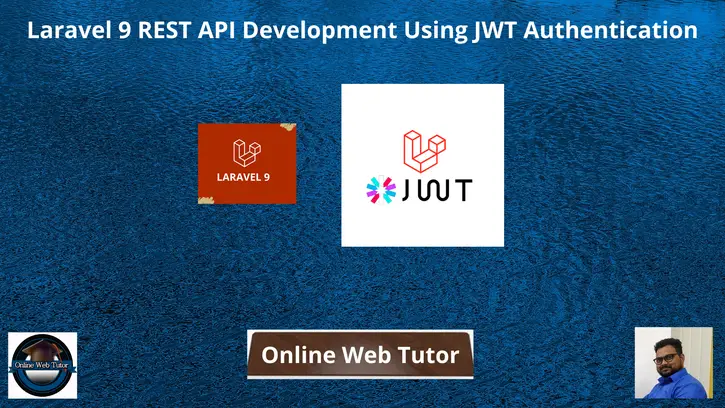Inside this article we will learn one more important concept of laravel i.e Laravel 9 REST API Development Using JWT Authentication. This will be step by step guide to create restful services from scratch.
REpresentational State Transfer (REST) is an architectural style that defines a set of constraints to be used for creating web services. REST API is a way of accessing web services in a simple and flexible way without having any processing.
In this article we will create a secure set of rest apis using laravel using JWT auth. We will use a JWT package to implement the concept of JWT authentication.
What we will do in this article –
- User Register API
- Login API
- Refresh Token API
- Logout API
- Create Todo API
- List Todo API
- Single Todo details API
- Update Todo API
- Delete Todo API
Above are the apis, we will create using jwt authentication.
Learn More –
- Laravel 9 REST API Development Using Passport Tutorial
- Laravel 9 REST API Development Using Sanctum Tutorial
- Laravel 9 Scout How To Add Full Text Search in Table
- Laravel 9 Seed Database Using Faker Library Tutorial
Let’s get started.
Laravel Installation
Open terminal and run this command to create a laravel project.
composer create-project laravel/laravel myblogIt will create a project folder with name myblog inside your local system.
To start the development server of laravel –
php artisan serveURL: http://127.0.0.1:8000
Assuming laravel already installed inside your system.
Create Database & Connect
To create a database, either we can create via Manual tool of PhpMyadmin or by means of a mysql command.
CREATE DATABASE laravel_app;
To connect database with application, Open .env file from application root. Search for DB_ and update your details.
DB_CONNECTION=mysql DB_HOST=127.0.0.1 DB_PORT=3306 DB_DATABASE=laravel_app DB_USERNAME=root DB_PASSWORD=root
Install And Configure Laravel JWT Auth
JSON Web Token (JWT) is an open standard (RFC 7519), and it represents a compact and self-contained method for securely transmitting information between parties as a JSON object.
Open project into terminal and run this command.
$ composer require php-open-source-saver/jwt-auth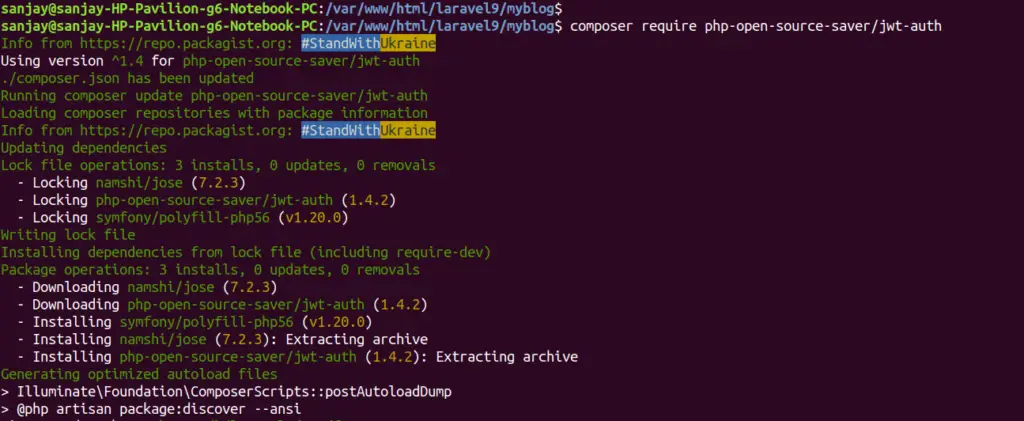
Publish Provider
Back to project terminal and run this command.
$ php artisan vendor:publish --provider="PHPOpenSourceSaver\JWTAuth\Providers\LaravelServiceProvider"Generate JWT Secret Keys
$ php artisan jwt:secretIt will generate few JWT secret keys and save into .env file. You should see these keys into .env file. These keys handle the token encryption.
JWT_SECRET=ncXDYGJAU30WPY09AgijRXRnFppA3MhZGCG3sDnYhxOCRuFbaXbkYUzvfxg1BmPF
JWT_ALGO=HS256Configure AuthGuard
We need to make a few changes to configure Laravel to use the JWT AuthGuard to power the application authentication.
To configure guard, Open auth.php file from /config folder.
//...
'defaults' => [
'guard' => 'api',
'passwords' => 'users',
],
'guards' => [
'web' => [
'driver' => 'session',
'provider' => 'users',
],
'api' => [
'driver' => 'jwt',
'provider' => 'users',
],
],
//...Update User Model
When we install laravel setup, by default we get a model User.php inside /app/Models folder.
use PHPOpenSourceSaver\JWTAuth\Contracts\JWTSubject; // Add this
class User extends Authenticatable implements JWTSubject {}Open User.php and update with this code.
<?php
namespace App\Models;
use Illuminate\Contracts\Auth\MustVerifyEmail;
use Illuminate\Database\Eloquent\Factories\HasFactory;
use Illuminate\Foundation\Auth\User as Authenticatable;
use Illuminate\Notifications\Notifiable;
use PHPOpenSourceSaver\JWTAuth\Contracts\JWTSubject;
class User extends Authenticatable implements JWTSubject
{
use HasFactory, Notifiable;
/**
* The attributes that are mass assignable.
*
* @var array<int, string>
*/
protected $fillable = [
'name',
'email',
'password',
];
/**
* The attributes that should be hidden for serialization.
*
* @var array<int, string>
*/
protected $hidden = [
'password',
'remember_token',
];
/**
* The attributes that should be cast.
*
* @var array<string, string>
*/
protected $casts = [
'email_verified_at' => 'datetime',
];
/**
* Get the identifier that will be stored in the subject claim of the JWT.
*
* @return mixed
*/
public function getJWTIdentifier()
{
return $this->getKey();
}
/**
* Return a key value array, containing any custom claims to be added to the JWT.
*
* @return array
*/
public function getJWTCustomClaims()
{
return [];
}
}
Create Model & Migration For Todo
Open project into terminal and run this artisan command.
$ php artisan make:model Todo -m-m to create migration file as well.
Above command will generate two files. One is Model and second is migration file.
Model – Todo.php inside /app/Models folder
Migration – 2022_03_20_040948_create_todos_table.php inside /database/migrations
Open Todo.php and write this code into it.
<?php
namespace App\Models;
use Illuminate\Database\Eloquent\Factories\HasFactory;
use Illuminate\Database\Eloquent\Model;
class Todo extends Model
{
use HasFactory;
protected $fillable = [
'title',
'description'
];
}
Open Migration file 2022_03_20_040948_create_todos_table.php and write this code.
<?php
use Illuminate\Database\Migrations\Migration;
use Illuminate\Database\Schema\Blueprint;
use Illuminate\Support\Facades\Schema;
return new class extends Migration
{
/**
* Run the migrations.
*
* @return void
*/
public function up()
{
Schema::create('todos', function (Blueprint $table) {
$table->id();
$table->string('title');
$table->string('description');
$table->timestamps();
});
}
/**
* Reverse the migrations.
*
* @return void
*/
public function down()
{
Schema::dropIfExists('todos');
}
};
Run Migration
Back to terminal and run this command to migrate.
$ php artisan migrateCreate Controllers
Back to terminal and run these artisan commands to create.
Auth Api Controller
$ php artisan make:controller AuthControllerThis command will create a file AuthController.php inside /app/Http/Controllers folder.
Todo Api Controller
<meta http-equiv="content-type" content="text/html; charset=utf-8">$ php artisan make:controller TodoControllerThis command will create a file TodoController.php inside /app/Http/Controllers folder.
Now, we will start writing code inside all these controllers.
Open AuthController.php file and write this code into it.
<?php
namespace App\Http\Controllers;
use Illuminate\Http\Request;
use Illuminate\Support\Facades\Auth;
use Illuminate\Support\Facades\Hash;
use App\Models\User;
class AuthController extends Controller
{
public function __construct()
{
$this->middleware('auth:api', ['except' => ['login', 'register']]);
}
public function login(Request $request)
{
$request->validate([
'email' => 'required|string|email',
'password' => 'required|string',
]);
$credentials = $request->only('email', 'password');
$token = Auth::attempt($credentials);
if (!$token) {
return response()->json([
'status' => 'error',
'message' => 'Unauthorized',
], 401);
}
$user = Auth::user();
return response()->json([
'status' => 'success',
'user' => $user,
'authorisation' => [
'token' => $token,
'type' => 'bearer',
]
]);
}
public function register(Request $request)
{
$request->validate([
'name' => 'required|string|max:255',
'email' => 'required|string|email|max:255|unique:users',
'password' => 'required|string|min:6',
]);
$user = User::create([
'name' => $request->name,
'email' => $request->email,
'password' => Hash::make($request->password),
]);
$token = Auth::login($user);
return response()->json([
'status' => 'success',
'message' => 'User created successfully',
'user' => $user,
'authorisation' => [
'token' => $token,
'type' => 'bearer',
]
]);
}
public function logout()
{
Auth::logout();
return response()->json([
'status' => 'success',
'message' => 'Successfully logged out',
]);
}
public function refresh()
{
return response()->json([
'status' => 'success',
'user' => Auth::user(),
'authorisation' => [
'token' => Auth::refresh(),
'type' => 'bearer',
]
]);
}
}
Open TodoController.php file and write this code into it.
<?php
namespace App\Http\Controllers;
use Illuminate\Http\Request;
use App\Models\Todo;
class TodoController extends Controller
{
public function __construct()
{
$this->middleware('auth:api');
}
public function index()
{
$todos = Todo::all();
return response()->json([
'status' => 'success',
'todos' => $todos,
]);
}
public function store(Request $request)
{
$request->validate([
'title' => 'required|string|max:255',
'description' => 'required|string|max:255',
]);
$todo = Todo::create([
'title' => $request->title,
'description' => $request->description,
]);
return response()->json([
'status' => 'success',
'message' => 'Todo created successfully',
'todo' => $todo,
]);
}
public function show($id)
{
$todo = Todo::find($id);
return response()->json([
'status' => 'success',
'todo' => $todo,
]);
}
public function update(Request $request, $id)
{
$request->validate([
'title' => 'required|string|max:255',
'description' => 'required|string|max:255',
]);
$todo = Todo::find($id);
$todo->title = $request->title;
$todo->description = $request->description;
$todo->save();
return response()->json([
'status' => 'success',
'message' => 'Todo updated successfully',
'todo' => $todo,
]);
}
public function destroy($id)
{
$todo = Todo::find($id);
$todo->delete();
return response()->json([
'status' => 'success',
'message' => 'Todo deleted successfully',
'todo' => $todo,
]);
}
}
Add API Routes
Open api.php from /routes folder. Add these routes into it.
//...
use App\Http\Controllers\AuthController;
use App\Http\Controllers\TodoController;
//...
Route::controller(AuthController::class)->group(function () {
Route::post('login', 'login');
Route::post('register', 'register');
Route::post('logout', 'logout');
Route::post('refresh', 'refresh');
});
Route::controller(TodoController::class)->group(function () {
Route::get('todos', 'index');
Route::post('todo', 'store');
Route::get('todo/{id}', 'show');
Route::put('todo/{id}', 'update');
Route::delete('todo/{id}', 'destroy');
});
Open terminal and run this artisan command to see all available routes.

Application Testing
Run this command into project terminal to start development server,
php artisan serveRegister API
URL – http://127.0.0.1:8000/api/register
Method – POST
Header –
Content-Type:application/json
Accept:application/jsonBody –
{
"name": "Sanjay Kumar",
"email": "sanjay@gmail.com",
"password": "123456"
}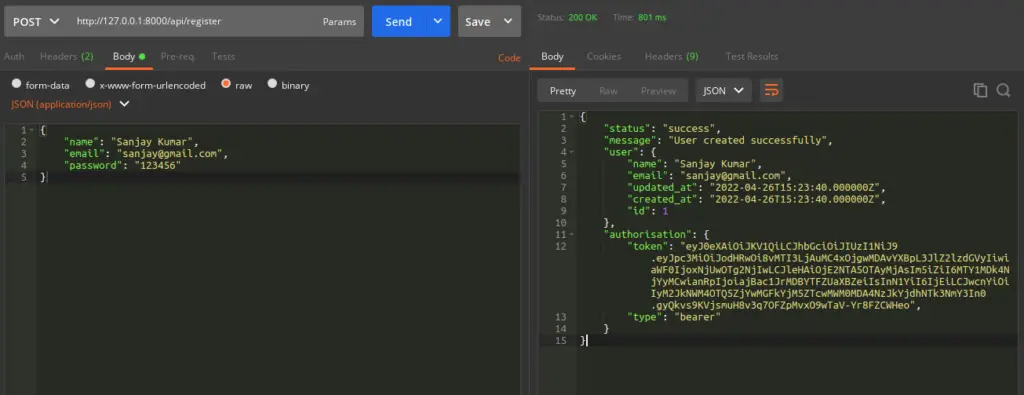
Login API
URL – http://127.0.0.1:8000/api/login
Method – POST
Header –
Content-Type:application/json
Accept:application/jsonBody –
{
"email": "sanjay@gmail.com",
"password": "123456"
}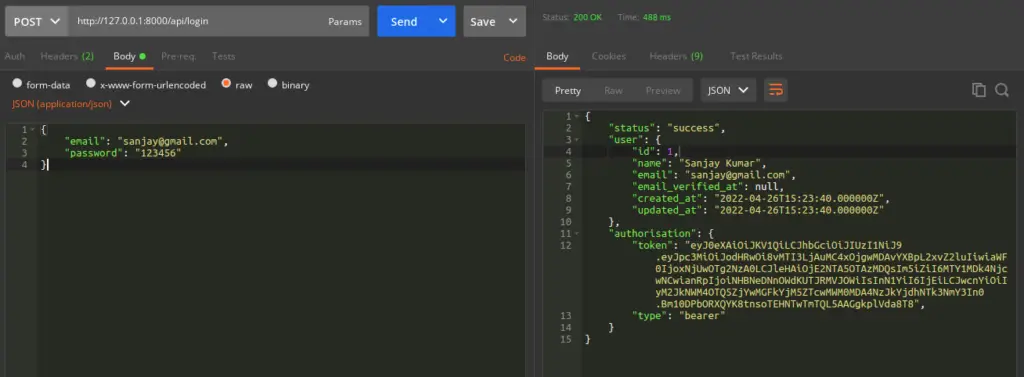
Refresh Token API
URL – http://127.0.0.1:8000/api/refresh
Method – POST
Header –
<meta http-equiv="content-type" content="text/html; charset=utf-8">Authorization:Bearer <token>
Accept:application/json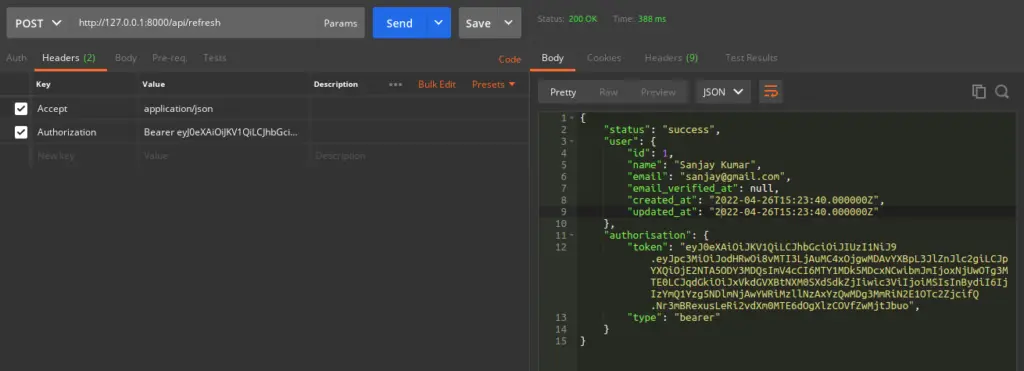
Logout API
URL – http://127.0.0.1:8000/api/logout
Method – POST
Header –
Authorization:Bearer <token>
Accept:application/json
Create Todo API
URL – http://127.0.0.1:8000/api/todo
Method – POST
Header –
Content-Type:application/json
Authorization:Bearer <token>
Accept:application/jsonBody –
{
"title": "Post 1",
"description": "Sample Post 1"
}
List Todo API
URL – http://127.0.0.1:8000/api/todos
Method – GET
Header –
Authorization:Bearer <token>
Accept:application/json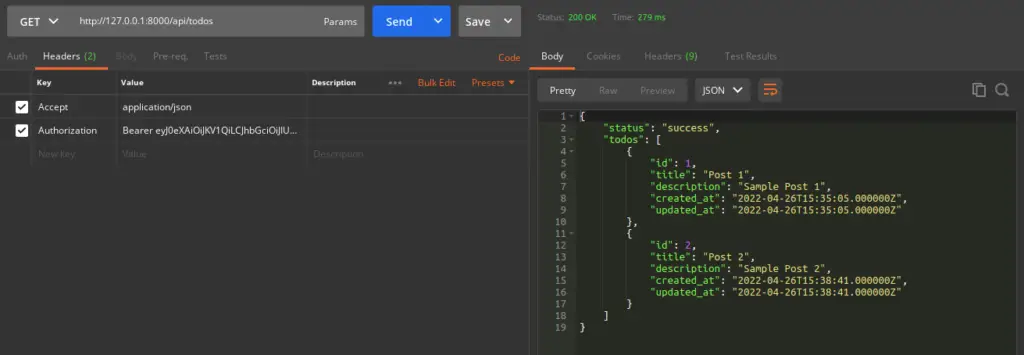
Single Todo Detail API
URL – http://127.0.0.1:8000/api/todo/1
Method – GET
Header –
Authorization:Bearer <token>
Accept:application/json
Update Todo API
URL – http://127.0.0.1:8000/api/todo/1
Method – PUT
Header –
Content-Type:application/json
Authorization:Bearer <token>
Accept:application/jsonBody –
{
"title": "Post 2 update",
"description": "Sample Post 2 content updated"
}
Delete Todo API
URL – http://127.0.0.1:8000/api/todo/1
Method – DELETE
Header –
Authorization:Bearer <token>
Accept:application/json
We hope this article helped you to learn about Laravel 9 REST API Development Using JWT Authentication in a very detailed way.
If you liked this article, then please subscribe to our YouTube Channel for PHP & it’s framework, WordPress, Node Js video tutorials. You can also find us on Twitter and Facebook.
Read more